2019 Appalachian Trail Thru-Hiker Survey: Top Tents and Shelters
Each year, The Trek surveys long-distance hikers on the Appalachian Trail (AT) regarding the shelter systems they use, such as tents and hammocks. In this post we cover the types of shelters used, tent use with significant others and dogs, tarp sizes for hammocks and tarps alone, and the top brands and models of shelter systems. For the details, keep reading, or skip to the TL;DR at the end.
The Hiker Sample
365 hikers participated in the survey, all of whom had walked a section or thru-hike of the AT in 2019. Almost three quarters (70%) were thru-hikers and the rest were section hikers. For more details on the hiker demographics, check out our post with general information from the survey.
Read Next: Our Current Favorite Backpacking Tents for a Thru-Hike
Related
Shelter System Types
Per usual, the majority of hikers used tents, while about a tenth of hikers used hammocks. All other forms of shelters were only rarely used. Due to confusion in previous years about what we meant by “hybrid” tents, we included a category for “trekking pole tents” this year and left out the hybrid category.
Tent Capacity
The vast majority of people who hiked with a significant other used tents (89.3%), including hybrid/trekking pole tents. (Keep in mind that more than one person from a couple might have completed the survey, which could skew the results a little.) This percentage is down a bit from 2018, when 97% of couples used tents. However, since only 56 survey respondents hiked most of the way with a significant other, that’s not really enough information to make strong conclusions about the lower percentage. I would still recommend that couples planning a thru-hike together should probably use a tent.
Everyone (100%) who hiked with a dog used a tent, with some (60%) using a trekking pole tent. We never have much data on hiking with dogs (only five survey respondents hiked with dogs this year). Still, from year to year, we consistently see that hikers with dogs use tents, so I strongly recommend that anyone attempting a thru-hike with a dog should use a tent.
While solo hikers often use two-person tents to have a little more room, the size of tent needed depends on how many people and dogs are using it. For this reason, I looked at tent size by hiking partners. Keep in mind that some people hiked with friends or family, and they were lumped with the solo hikers because it wasn’t clear whether they shared a tent. Furthermore, very few hikers brought a dog for the majority of the hike, so these numbers are based on limited data from only five hikers.
About half of solo tenters used a two-person tent and less than half used a one-person tent, while it was rare for them to use a three-person tent. In contrast, hikers who went with a significant other most of the way used two-person tents more than solo hikers, a quarter of them used three-person tents, while one-person tents were uncommon for these hikers (used by 8%). Although our data on hikers with dogs is limited, it does appear that two-person (or more) tents are the way to go if you plan to hike with a dog the majority of the way. (This likely also depends on the size of the dog.)
Tarp Size
For hikers using hammocks, the tarp they used as a rainfly was most often about 10 x 12 feet in size. About one-third of hammock users preferred a tarp shaped for their hammock. In my experience, a rectangular tarp is more convenient on the AT, even with hammock use, because it can be attached to the front of a lean-to for protection from rain/snow or used on its own if there are no trees nearby. During my thru-hike, I was able to persuade people in crowded lean-tos to make room for me because I hung my tarp in front to block rain, snow, and/or wind, so I personally think a rectangular tarp is the best option even for hammockers.
Only four hikers in our survey this year used a tarp on its own (some mentioned a bug bivy as well), and all of them used tarps of the size 8 x 10 feet. Because these tarps only need to cover the length of a hiker’s body, not the extended length of a hammock, they don’t have to be as long.
Popular Brands and Models
Lastly, we asked hikers what their favorite brands and models were for their shelter systems. Here are the rankings by popularity.
Top Tent Brands
- Big Agnes (114 hikers’ favorite)
- Zpacks (76)
- NEMO (27)
- MSR (19)
- TarpTent (15)
- REI (14)
- Six Moon Designs (13)
- Gossamer Gear (7)
- Lightheart Gear (5)
Top One-Person Tent Models
1) Big Agnes Copper Spur UL 1 (16)

2) REI Quarter Dome (9)

3) Six Moon Designs Lunar Solo (8)

4) NEMO Hornet (7) and Gossamer Gear The One (7)

5) Big Agnes Fly Creek UL 1 (6)

Top Two-Person Tent Models
1) Zpacks Duplex (58)

2) Big Agnes Fly Creek UL 2 (28)

3) Big Agnes Copper Spur UL (22)

4) NEMO Hornet 2-person (17) and Big Agnes Tiger Wall UL 2 (17)
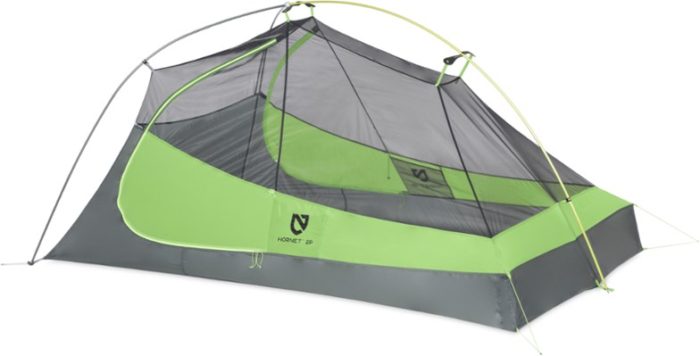
5) MSR Hubba Hubba (12)
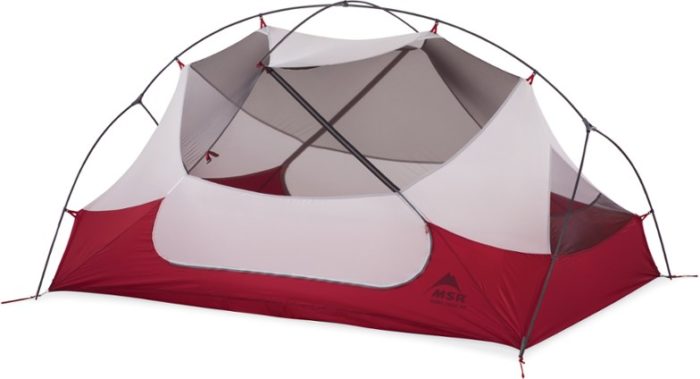
Top Three-Person Tent Models
1) Big Agnes Copper Spur UL 3 (9)

2) Zpacks Triplex (4)

Top Trekking Pole Tent Models
Because the most popular trekking pole tents varied in capacity, I also listed these among the tents by size above. Here are the most popular models of ultralight trekking pole tents, regardless of capacity, in order of popularity.
1) Zpacks Duplex (58)

2) Six Moon Designs Lunar Solo (8)

3) Gossamer Gear The One (7) and Tarptent Protrail (7)

4) Zpacks Triplex (4)

Tent Dissatisfaction
A lot of the comments on my survey posts have asked about dissatisfaction with gear. I find this challenging to describe accurately, since nearly all hikers report being at least somewhat satisfied with their gear, and we get down to really small numbers for comparison when it comes to specific models. For the models used by five or more hikers, I’ve listed them below in order, with the highest percentage dissatisfied first:
- Plexamid (ZPacks) 3/10 disliked (poles cracked)
- Hornet 1-p (NEMO) 2/7 disliked
- Protrail (TarpTent) 2/7 disliked
- The One (Gossamer Gear) 2/7 disliked
- Triplex (ZPacks) 1/4 disliked
- Hornet 2-p (NEMO) 2/17 disliked
- Duplex (ZPacks) 5/58 disliked (waterproofing issues)
- Fly Creek HV UL 2 (Big Agnes) 2/28 disliked (poles cracked, waterproofing issues)
- Copper Spur UL 2 (Big Agnes) 1/22 disliked (multiple repairs)
Some hikers mentioned having waterproofing issues with other models, but still rated they were generally satisfied with the tent. Based on this data and my personal experience, my general conclusion is that poles breaking is a more specific problem with the model that shouldn’t be happening much. However, seams leaking and waterproofing wearing down is a problem that will occur with any tent over time. Unless it is extreme leaking, you should be able to reseal your tent with waterproofing spray, silnylon patches, or other forms of repair.
Furthermore, if your tent is leaking from the bottom, the problem probably isn’t your tent; the problem is the terrain you’re on and/or how you set up your footprint. Any three-season tent will take in water if enough water is flowing underneath your tent, if the snow around it is high enough, or if the footprint isn’t placed properly.
Problem with Hammock Brands and Models
Unfortunately, I made a mistake in the survey this year, and no one who used a hammock saw the questions about hammock brands and models. So we don’t have data on that this year. If you need guidance on hammock brands/models to buy, I recommend you check out our post from last year.
TL;DR
- If you’re unsure of the shelter type to use on your hike, a tent is the way to go, particularly if you are hiking with a significant other or a dog.
- If you want to try out something different or more lightweight, go with an ultralight trekking pole tent or with a hammock. All other shelter systems (including no shelter at all), are highly uncommon for long-distance hikes on the AT.
- People hiking with a dog or a significant other would likely need a two- or three-person tent. People hiking solo are fine with a one- or two-person tent.
- If you intend to use a hammock, make sure your tarp is long enough to cover the hammock. In general, a 10 by 12 foot tarp is most popular for hammockers.
- If you intend to use only a tarp, a tarp with dimensions of about 8 x 10 feet is probably sufficient.
- Big Agnes and ZPacks are by far the most popular brands for tents, with Big Agnes taking the lead for standard tents and ZPacks taking the lead for ultralight ones.
- Very few, but some, hikers had problems with the Plexamid and Fly Creek UL 2 poles breaking.
The most common complaint hikers had with their tents was waterproofing issues. If this happens to you, it is likely you can repair the holes or seams rather than replacing your tent entirely. If your tent leaks water from the bottom, it probably is an issue with the setup, and isn’t your tent’s fault.
Thank You!
Many thanks to the hikers who participated in the survey! Congratulations to you all and to the dogs who hiked with you! I would never get this data or get these posts done if it weren’t for Zach Davis and Maggie Slepian—thanks to you both.
More from the Hiker Survey
Check out our previous post with general hiker information and footwear. Upcoming posts from this year’s survey will cover backpacks, sleeping bags and pads, and stoves/food/water. To stay updated on the subsequent hiker survey posts, subscribe to The Trek newsletter.
This website contains affiliate links, which means The Trek may receive a percentage of any product or service you purchase using the links in the articles or advertisements. The buyer pays the same price as they would otherwise, and your purchase helps to support The Trek's ongoing goal to serve you quality backpacking advice and information. Thanks for your support!
To learn more, please visit the About This Site page.

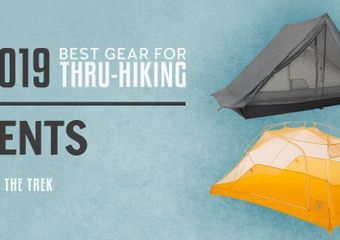
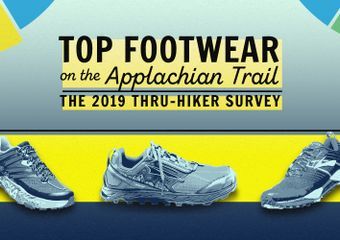

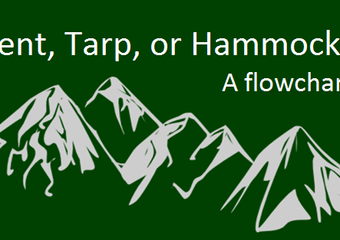
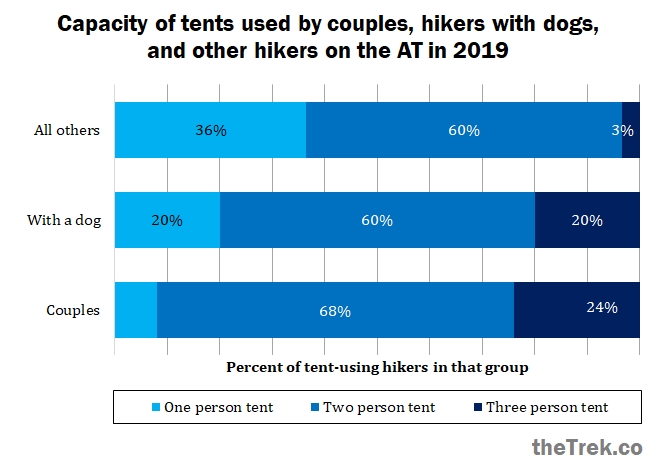
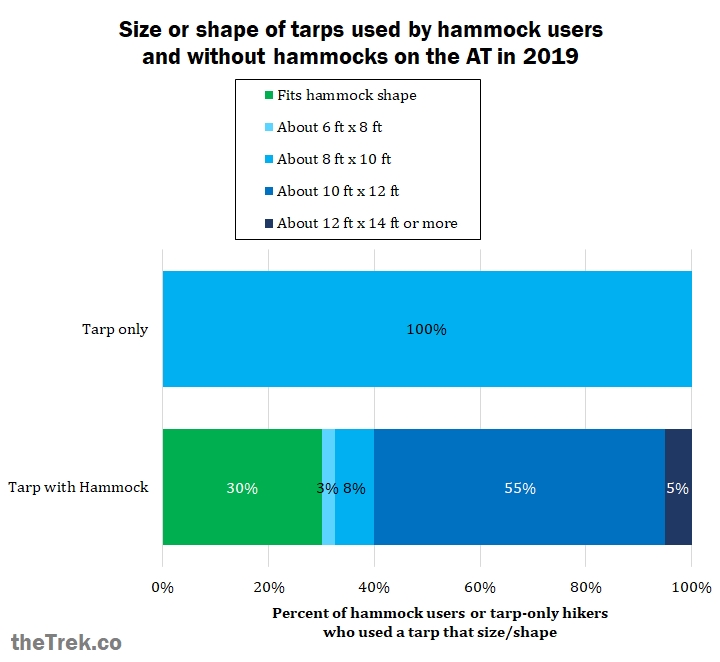

Comments 7
I have to say, for the money, my good ol’ REI Quarter Dome 1 has been an incredible deal. I’ve used it now for 3,500+ miles of backpacking and it’s still going strong. Pretty light, easy to use. I have other tents now that I appreciate, but I still love this one a lot.
The very best tent is the Tarptent Rainbow with reinforced end carbon poles and Cuben fiber material. It fits in every shelter on the AT. It stands alone, no stakes needed. (Stakes are nasty for the environment folks.) Of course, Tarptent won’t make it because it would cost too much, but hey, it works.
“Fits in every shelter?!”
I hope they don’t make a tent aimed at being set up in shelters …
I was subscribed to all your posts and then the notices quit coming so I’m just bookmarked and check in from time to time.
I’m glad you are revitalized.
Thanks for the good work.
Looking forward to the next. We are back out March 14 so don’t wait too long. :).